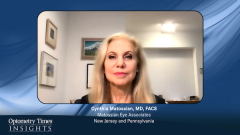
Treatment Options for Dry Eye Flares
Cynthia Matossian, MD, FACS, discusses the short- and long-term treatment options for dry eye flares.
Cynthia Matossian, MD, FACS: What are the consequences of untreated flares? Flares are worsening of inflammation, which is the root cause of dry eye disease. Flares impact the quality of life of every suffering patient. Flares impact their reading speed. Flares impact their ability to work effectively. Even if they show up to work and sit in that office chair, or maybe in front of the monitor, maybe their work productivity is not as strong as it would be otherwise. That’s called presentism, meaning they are present but are not so productive. There’s also higher absenteeism among patients who suffer from dry eye flares.
Another important point is when their eyes hurt, they’re not able to wear their contact lenses. This can attribute to all kinds of issues. Some patients feel differently about their image with spectacles versus contact lenses. Maybe they can’t play sports because it’s difficult to participate with spectacles on. Flares also impact the mood of the patient. They’re grumpier. They snap back at family members, at colleagues. And lastly, if we don’t treat and stabilize that tear film, we’re going to have refractive surprises when it comes to nailing that outcome, especially if the patient has paid their hard-earned dollars for presbyopia-correcting IOLs [intraocular lenses] or toric IOLs. We may not be able to nail that refractive target based on measurements on an unreliable and dysregulated tear film. It’s critical to tune up the surface prior to corneal procedures like Lasik and all cataract surgeries, whether monofocal or advanced technology IOLs.
When a patient is suffering from ocular discomfort, their eyes are tearing, they say it feels like they have gravel or pieces of glass in their eye. “I can hardly keep my eyes open.” They are describing a dry eye flare. What are they looking for? They are looking for you to help them come up with quick relief.
Steroids do a great job because they are anti-inflammatory. They calm that inflammation and suppress that vicious cycle. We are fortunate that we now have an FDA-approved steroid, loteprednol etabonate 0.25%, specifically with the indication to treat dry eye flares on an intermittent basis for up to 14 days. That is a great way to start giving that patient the comfort they need.
Perhaps you’re going to co-introduce a long-term therapy with an immunomodulator. This short-term steroid will jump-start things, making the patient feel better. Some of the immunomodulators take weeks to months to work. This way, while they’re working the patient is getting the benefit of the steroid. So it’s a one-two punch. One is the immediate relief for the patient who’s desperate, and the other is the long-term chronic therapy.
The other thing is the steroid is safe. We want something that’s quick acting. We want something that’s safe. The ester steroid has an extremely safe profile, and clinical studies have demonstrated that.
Transcript edited for clarity.
Newsletter
Want more insights like this? Subscribe to Optometry Times and get clinical pearls and practice tips delivered straight to your inbox.















































.png)


